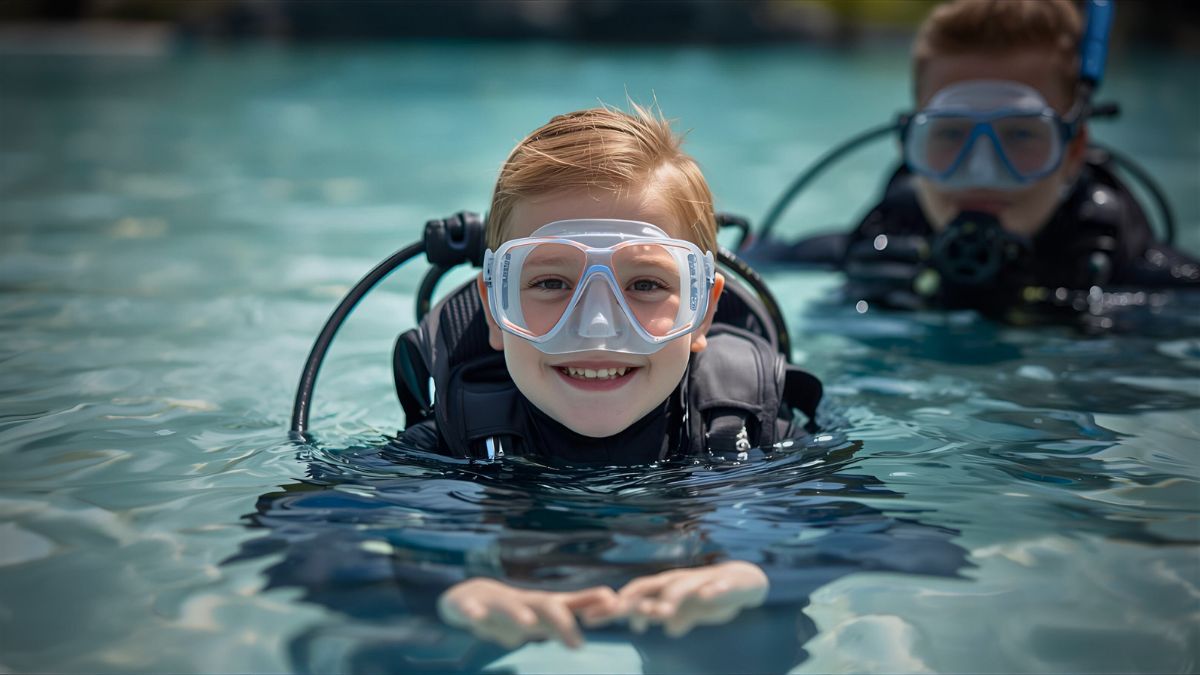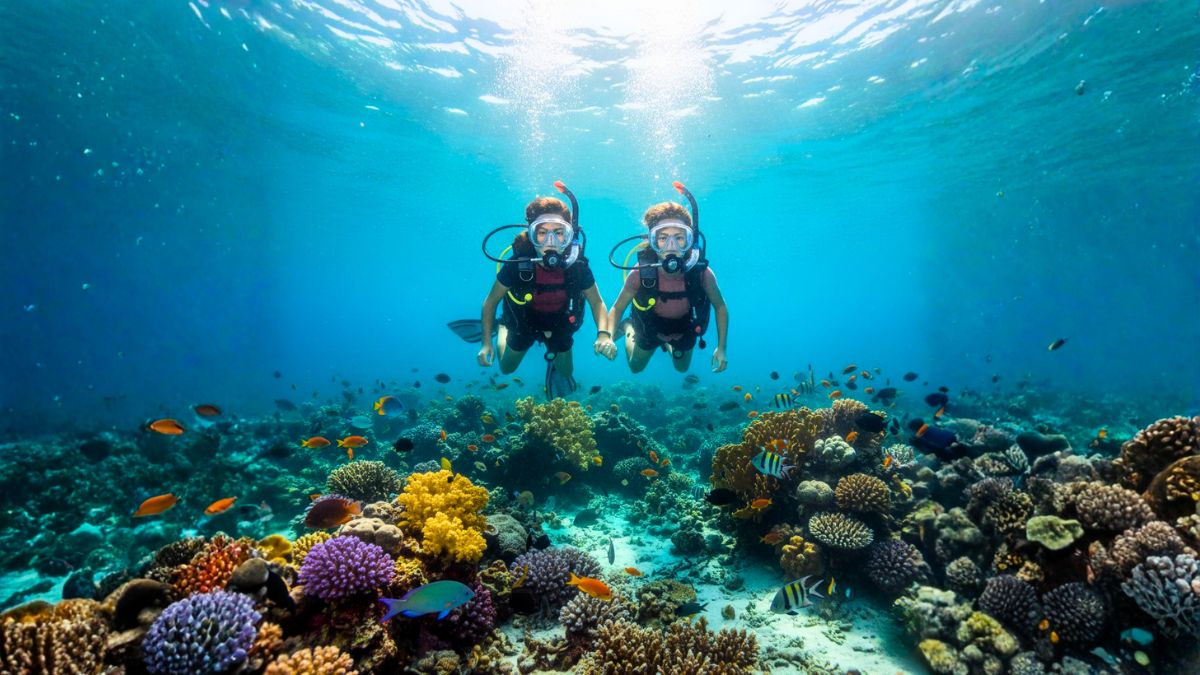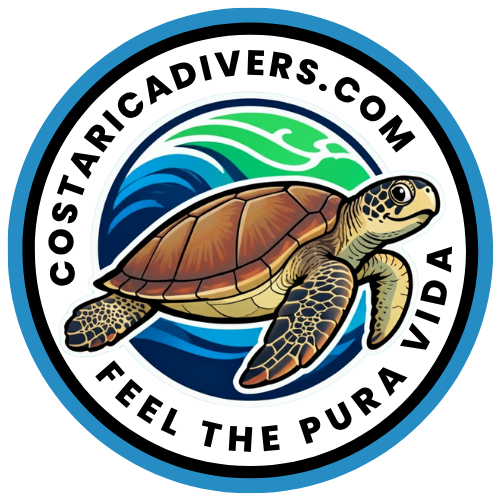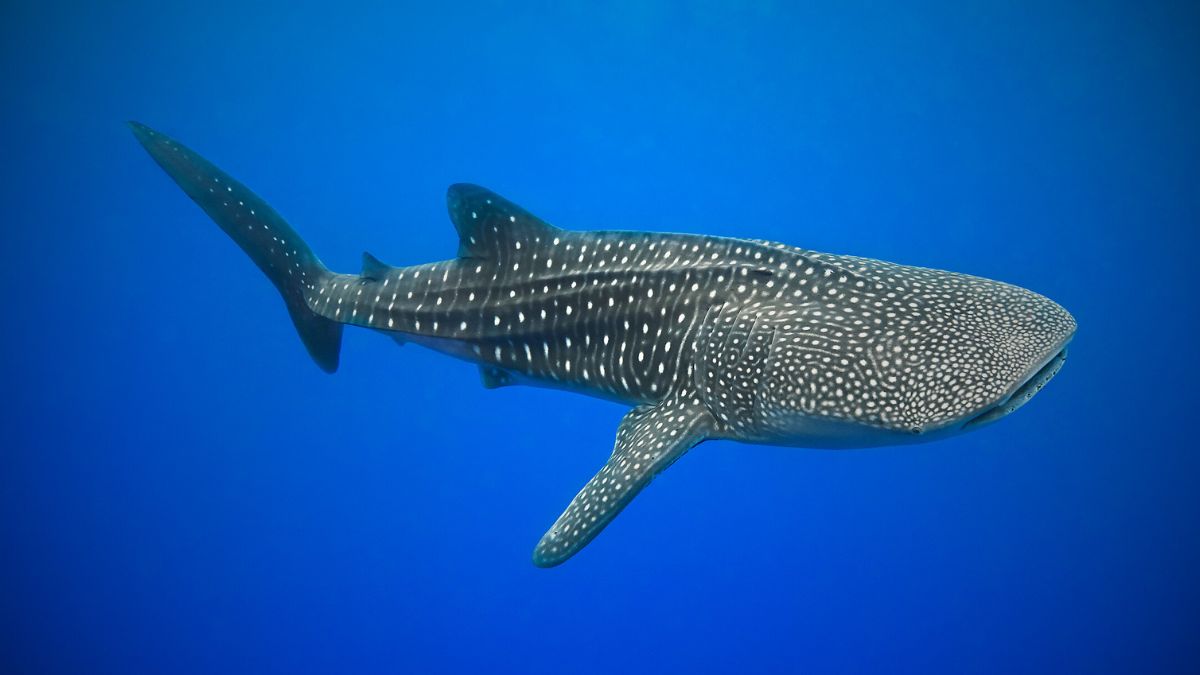If your child has been begging to try scuba diving, you’re probably wondering: is there a minimum age? Is my child old enough? And most importantly – is it safe?
I’ve worked with hundreds of young divers at our center, and I understand the mix of excitement and worry parents feel. The good news is that kids can start exploring the underwater world much earlier than you might think, with proper training and age-appropriate programs.
The minimum age to scuba dive depends on the program. Kids as young as 8 can experience scuba in a pool, while full certification starts at age 10. But age is just one factor. In this guide, I’ll walk you through everything you need to know about age requirements, safety considerations, and how to tell if your child is truly ready.
What Is the Minimum Age to Scuba Dive?
The quick answer: 10 years old for certification, 8 years old for introductory pool programs.
Most major certification agencies, including PADI (the world’s largest), set the minimum age for Junior Open Water Diver certification at 10 years. This isn’t an arbitrary number. It’s based on decades of research into child development, physical capabilities, and cognitive maturity.
Before age 10, children can still experience scuba diving through specially designed programs like PADI Bubblemaker (starting at age 8), which take place in controlled pool environments with strict depth limits.
But here’s something important I tell every parent: just because a child meets the minimum age doesn’t automatically mean they’re ready. Every child develops differently. Some 10-year-olds are absolutely prepared for certification, while others might benefit from waiting another year or two.
Age-by-Age Guide: When Can Kids Start Scuba Diving?
Let me break down exactly what’s available at each age, so you can see where your child fits.
What Can 8-9 Year Olds Do?
At this age, kids can participate in pool-based scuba programs designed specifically for their size and ability level.
PADI Bubblemaker
This is the most popular option for 8 and 9-year-olds. This program lets kids use real scuba equipment in a swimming pool under close instructor supervision. They’ll dive to a maximum depth of 6 feet (2 meters) and learn basic skills like breathing underwater, clearing their mask, and communicating with hand signals.
Think of Bubblemaker as a “test drive” for scuba diving. It’s all about fun and building comfort in the water. There’s no classroom work, no tests, and no pressure. Kids simply experience the magic of breathing underwater for the first time.
PADI Seal Team
This course takes things a step further for kids who want more than a one-time experience. This multi-session program teaches additional skills through fun “AquaMissions” like underwater navigation, buoyancy control, and even simulated wreck exploration. Kids can progress through various missions and earn recognition as they advance.
Both programs are pool-only at this age. No open water diving yet, but these experiences build confidence and skills that make future certification much easier.
Did you know? Kids who start with Bubblemaker or Seal Team programs often complete their Open Water certification faster when they turn 10, because they’re already comfortable with the equipment and basic skills.
When Can Kids Get Certified? (Age 10 Minimum)
At age 10, children can earn their first real scuba certification: Junior Open Water Diver.
This is the same comprehensive course that adults take. Your child will complete theory training (either through eLearning or in-classroom sessions), practice skills in a pool, and then complete four open water dives to demonstrate their abilities.
The course typically takes 3-4 days to complete if your child finishes the theory portion beforehand. Some families do this during vacation, while others spread it over several weekends at home.
Important restrictions for 10 and 11-year-olds
Maximum depth is 40 feet (12 meters). This is shallower than adult limits but perfect for most recreational dive sites with the best marine life.
They must dive with a parent, legal guardian, or PADI Professional. You can’t send your 10-year-old diving with just their older sibling or family friend.
These restrictions exist for safety and aren’t negotiable. But honestly, the 40-foot depth limit isn’t limiting at all. Some of the most incredible diving in Costa Rica happens in that depth range – colorful reefs, sea turtles, tropical fish, and more.

What Changes at Age 12?
When your child turns 12, their diving world expands significantly.
The depth limit increases to 60 feet (18 meters). This opens up many more dive sites and allows them to explore deeper reefs and structures.
They can dive with any certified adult, not just parents or professionals. If you have a trusted friend or relative who dives, your 12-year-old can now buddy up with them.
At this age, kids can also pursue Junior Advanced Open Water Diver certification. This course introduces specialty areas like underwater navigation, deep diving (to their 60-foot limit), night diving, and more. It’s a great way to build experience and confidence.
Many specialty courses also become available at 12: underwater photography, fish identification, search and recovery, and others. If your child is passionate about diving, this age offers lots of opportunities to expand their skills.
What Happens at Age 15?
This is when everything changes. At 15, the “Junior” designation automatically drops from all certifications.
Your child’s Junior Open Water Diver card becomes a full Open Water Diver certification. Junior Advanced becomes Advanced Open Water. No additional training or testing required – it’s an automatic upgrade.
What this means:
- No more depth restrictions beyond standard recreational limits (60 feet for Open Water, 100 feet for Advanced Open Water).
- No more age-based supervision requirements. Standard buddy system rules apply.
- They can begin the professional path toward becoming a Divemaster if they’re interested.
- Full adult privileges and responsibilities in the diving world.
Many 15-year-olds who started diving young have impressive logbooks by this age. I’ve seen teenagers with 50, 100, even 200+ dives under their belt by the time they graduate high school.
Parent Tip: The automatic upgrade at age 15 means any Junior certifications your child earns are never wasted. They count toward their full diving credentials and experience requirements.
Is My Child Ready to Scuba Dive? (Beyond Age Requirements)
Meeting the minimum age is just the starting point. Here’s how to assess if your child is truly ready for scuba diving.
Physical Readiness Factors
Swimming ability is non-negotiable. Your child needs to be a confident, comfortable swimmer. Most courses require students to swim 200 meters continuously and tread water for 10 minutes. If your child struggles with basic swimming, focus on swim lessons first.
Physical strength matters, but less than you might think. Yes, scuba equipment is heavy on land. A full tank and gear can weigh 30-40 pounds. But your child doesn’t need to be an athlete. In the water, everything becomes nearly weightless due to buoyancy. What matters is that they can handle the equipment getting in and out of the water, often with help from instructors.
What about health?
Ear equalization is crucial. As divers descend, they must “equalize” their ears to prevent pain and injury. This means equalizing pressure in the middle ear, similar to what you do on an airplane. Most kids can do this easily, but some have difficulty due to smaller, less-developed Eustachian tubes. If your child frequently has ear infections or struggles with pressure changes on planes, discuss this with a dive instructor before enrolling.
General health and fitness should be good. Certain medical conditions (severe asthma, heart problems, seizure disorders) can prevent diving. You’ll complete a medical questionnaire before any course. If any questions raise concerns, you’ll need clearance from a doctor familiar with dive medicine.

Mental and Emotional Readiness
Age requirements address physical development, but mental readiness is equally important.
Can your child follow multi-step instructions? Scuba diving requires remembering procedures, following safety protocols, and executing skills in sequence. If your child gets frustrated easily or struggles to focus on tasks, they might not be ready yet.
How do they handle new or stressful situations? Diving can feel overwhelming at first – breathing underwater isn’t natural. Kids who adapt well to new experiences and don’t panic when things feel unfamiliar tend to do better.
Motivation issues
Is the interest genuine or parent-driven? This is huge. I’ve seen parents push reluctant kids into diving because they love it. That rarely ends well. Your child should actively want to dive, not just agree to make you happy.
Do they understand responsibility? Divers are responsible for their own safety and their buddy’s safety. A 10-year-old doesn’t need adult-level judgment, but they do need to understand that diving rules aren’t suggestions.
Here’s my honest assessment after certifying hundreds of young divers: maturity matters more than age. I’ve had incredibly responsible 10-year-olds who excelled, and immature 14-year-olds who weren’t ready. You know your child best. Trust your instincts.
How Deep Can Kids Dive?
Depth restrictions exist for important safety reasons. Young bodies are still developing, and deeper depths carry increased risks.
Here’s a quick reference guide:

These limits aren’t arbitrary. They’re based on research into child physiology, decompression risk, and safety data from millions of dives.
The good news? Most of the ocean’s beauty exists in shallow water. Coral reefs, colorful fish, sea turtles, rays – you’ll find them all in the 20-40 foot range. The 40-foot limit for younger kids rarely feels restrictive.
Is Scuba Diving Safe for Kids?
I’ll be honest with you: no activity is 100% risk-free, including scuba diving.
But when age-appropriate restrictions are followed, proper training is completed, and qualified instructors supervise, scuba diving has an excellent safety record for children.
What Makes Kids Diving Safe?
Strict certification standards ensure every instructor teaching children has met rigorous requirements. At PADI-authorized dive centers like ours, instructors must maintain current certifications, insurance, and training specifically for working with young divers.
Age-appropriate equipment makes a huge difference. Modern manufacturers produce youth-sized masks, fins, wetsuits, and BCDs (buoyancy control devices) that fit properly. Ill-fitting equipment is dangerous; properly fitted gear is safe and comfortable.
Controlled progression means kids start in pools, master skills in calm conditions, then gradually move to open water under close supervision. Nobody throws a 10-year-old into deep ocean water on day one.
Conservative depth limits keep young divers in lower-risk environments. The shallower the dive, the lower the risk of decompression issues, nitrogen narcosis, and other depth-related problems.
What Are the Risks Parents Should Know?
I won’t sugarcoat this. Diving carries some inherent risks, just like many activities kids participate in.
The most common issues are minor: ear discomfort from improper equalization, minor scrapes from coral or rocks, or temporary anxiety about being underwater. These are manageable with proper instruction.
Did you know? According to safety data, when junior divers follow age restrictions and supervision requirements, their incident rate is comparable to adult recreational divers with similar experience levels.
Serious diving accidents are rare, especially among properly supervised junior divers. When they do occur, they’re usually related to panic, failure to follow procedures, or pre-existing medical conditions that should have been caught during medical screening.
Here’s perspective: diving has a lower injury rate than many popular youth sports like football, soccer, or skateboarding. I’m not saying it’s risk-free. I’m saying the risk is manageable and comparable to activities most parents already let their kids do.
What Are the Benefits of Scuba Diving for Kids?
Beyond the obvious thrill of exploring underwater, diving offers real developmental benefits for children.
Physical benefits include improved cardiovascular fitness, better coordination and body awareness, increased lung capacity, and full-body muscle engagement. Swimming with fins provides excellent low-impact exercise.
Mental and emotional growth is significant. Diving builds confidence as kids master challenging skills. It teaches responsibility because safety depends on following rules. It requires focus and concentration underwater. Many parents tell me diving has helped their anxious or ADHD kids develop better self-regulation skills.

Diving is a good activity for children
Educational value sneaks in naturally. Kids learn marine biology by observing sea creatures firsthand. They absorb basic physics concepts about pressure, buoyancy, and gas laws. Environmental awareness develops when they see fragile coral reefs and understand conservation needs.
Family bonding might be the biggest benefit. How many activities can parents and kids genuinely enjoy together through teenage years? Diving is one of the few. Some of my favorite moments at the dive center involve watching families explore underwater together, creating memories that last forever.
And here’s something your child will love: having a scuba certification makes them unique. While their classmates are playing video games, your kid is exploring shipwrecks and swimming with sea turtles. That’s pretty cool social currency for a young person.
How to Get Your Child Started in Scuba Diving
Ready to move forward? Here’s your roadmap.
Choosing the Right Program for Your Child’s Age
If your child is 8-9 years old: Start with a Bubblemaker experience. It’s a single session, low commitment, and lets your child try scuba without the pressure of full certification. If they love it, consider Seal Team for more extensive pool-based training.
If your child is 10-11 years old: You have options. If they’ve never tried scuba, a Discover Scuba Diving experience provides a taste before committing to full certification. If they’re ready and eager, go straight to Junior Open Water Diver certification.
Diving for teenagers
If your child is 12-14 years old and already certified: Look at Junior Advanced Open Water or specialty courses that match their interests (underwater photography, marine biology, navigation).
If your child is 15+: They can pursue any adult certification without junior restrictions.
Not sure which program fits? Contact your local dive center. Good instructors will ask questions about your child’s experience, comfort level, and goals before recommending a path.
What to Look for in a Dive Center for Kids
Not all dive centers are equally good with young divers. Here’s what to ask:
Does the instructor have experience teaching children? Teaching kids requires different skills than teaching adults. Look for instructors who genuinely enjoy working with young people and have patience for the unique challenges kids present.
Do they have youth-sized equipment? Properly fitting gear is essential for safety and comfort. Centers that regularly teach kids maintain a range of youth equipment sizes.
What’s their teaching approach? The best instructors balance fun with safety, keeping kids engaged while ensuring skills are mastered. Ask if you can observe part of a class or talk to other parents whose kids have trained there.
What’s their safety record? Reputable dive centers will discuss their safety protocols openly. If someone is evasive about safety questions, walk away.

How Much Does It Cost?
Junior Open Water Diver certification typically costs $400-700, depending on location and what’s included.
Most courses include:
- All instruction (theory, pool sessions, open water dives)
- Equipment rental during training
- Certification processing fees
- Educational materials
You’ll typically pay extra for:
- Personal items (mask, snorkel, fins) if you want to own them
- Any travel costs to reach open water dive sites
- Accommodation if training happens over multiple days away from home
Is it expensive? That depends on your perspective. Compared to a gaming console your child will use for a year or two, it’s similar cost. But diving is a lifelong skill that can bring decades of enjoyment and adventure.
Do Kids Need Their Own Scuba Equipment?
Short answer: not right away.
For initial certification, rental equipment included in your course fee is perfectly fine. Most kids are still growing, and buying equipment they’ll outgrow in a year doesn’t make financial sense.
If your child continues diving after certification and you’re doing multiple trips per year, consider purchasing personal items that affect comfort and hygiene:
Buy first: Scuba mask, snorkel, and fins. These are relatively inexpensive, don’t require perfect sizing, and having familiar, comfortable gear improves the experience.
What diving equipment should you buy?
Buy later: Wetsuit (if diving regularly in cooler water), dive computer (once they’re experienced enough to use it properly).
Keep renting: BCD, regulator, tanks. These are expensive, require maintenance, and kids outgrow them. Rental makes more sense until they’re fully grown.
One parent perspective: I’d rather buy my child dive gear that encourages outdoor adventure and learning than another meaningless toy. But that’s a personal decision every family makes differently.
Frequently Asked Questions
Can my 8-year-old get scuba certified?
No, the minimum age for scuba certification is 10 years old. However, 8-year-olds can participate in PADI Bubblemaker or Seal Team programs, which provide scuba experiences in swimming pools under close instructor supervision. These programs are excellent preparation for future certification.
Is 10 years old too young to scuba dive?
Ten is not too young for properly supervised scuba diving with appropriate depth and supervision restrictions. Children who are comfortable swimmers, can follow instructions, and show genuine interest often do excellently at age 10. The key is assessing your individual child’s physical and mental readiness beyond just their age.
What’s the difference between Junior and adult certification?
Junior certifications have age-based restrictions on depth and supervision requirements. For example, 10-11-year-old Junior Open Water Divers must dive with a parent, guardian, or PADI Professional and stay above 40 feet. At age 15, these restrictions automatically lift and the certification becomes a full adult credential with no additional testing required.
Can my child dive with me once certified?
It depends on their age. Junior Open Water Divers ages 10-11 must dive with a parent, legal guardian, or PADI Professional. At age 12, they can dive with any certified adult. Once they turn 15, standard buddy system rules apply and parent and child can dive together as equal buddies.
Is scuba diving dangerous for kids?
Scuba diving carries some inherent risk, like any adventure activity. However, when age-appropriate restrictions are followed, proper training is completed, and qualified instructors supervise, the safety record for junior divers is excellent. The injury rate is comparable to many popular youth sports. Proper training, equipment, and supervision make diving safe for children who meet the age and readiness requirements.
What Is the Right Age to Scuba Dive? Your Next Steps
So, is your child old enough to scuba dive? If they’re 10 or older, meet the physical and mental readiness factors we discussed, and show genuine interest – then yes, they’re probably ready.
If they’re younger, programs like Bubblemaker provide a safe, fun introduction that builds skills and excitement for future certification.
Starting young has real advantages. Kids who learn to dive at 10 or 12 become incredibly skilled by their late teens. They develop confidence, learn responsibility, and gain a hobby that brings joy throughout life. Plus, family dive trips create memories no theme park vacation can match.
Diving with your child in Costa Rica’s warm, clear waters – watching them marvel at a sea turtle gliding by or point excitedly at a school of colorful fish – those are moments you’ll treasure forever.
Sources used in writing this blog
- PADI “Open Water Diver Course Standards and Procedures.”
- Costa Rica Tourism Board (ICT). “Marine Protected Areas and Biodiversity.”
- DAN (Divers Alert Network) – Diving safety research and medical information
- Many years of training experience in diving among adults, teenagers, and children





